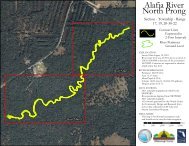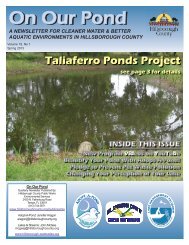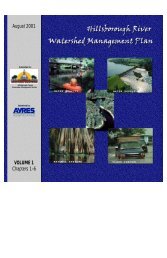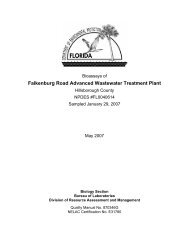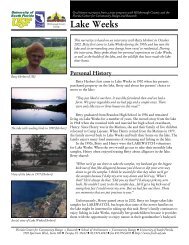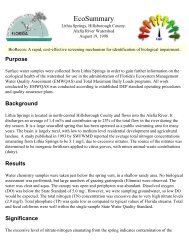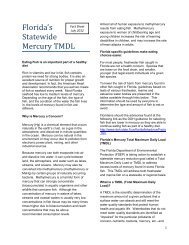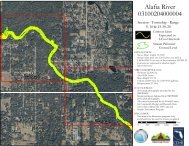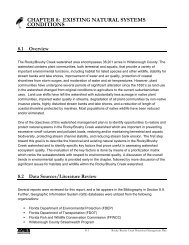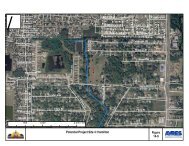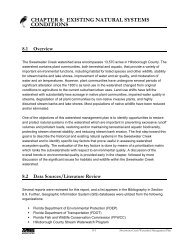Bullfrog Creek - Hillsborough County & City of Tampa Water Atlas
Bullfrog Creek - Hillsborough County & City of Tampa Water Atlas
Bullfrog Creek - Hillsborough County & City of Tampa Water Atlas
- No tags were found...
You also want an ePaper? Increase the reach of your titles
YUMPU automatically turns print PDFs into web optimized ePapers that Google loves.
Oral history narrative from a joint program with <strong>Hillsborough</strong> <strong>County</strong> and theFlorida Center for Community Design and Research<strong>Bullfrog</strong> <strong>Creek</strong>The following narrative has been written based on an interview conductedwith Jeanie and Pete Johnson at their home on <strong>Bullfrog</strong> <strong>Creek</strong> on June11, 2002. Both Jeanie and Pete grew up on <strong>Bullfrog</strong> <strong>Creek</strong> and with theirknowledge <strong>of</strong> the creek from childhood, they were able to describe the changesthat have occurred over the past fifty years. This narrative also reflects theimportance <strong>of</strong> the creek to them and others in the surrounding area.Jeanie and Pete Johnson (USF)<strong>Bullfrog</strong> <strong>Creek</strong> in June 2002 (USF)<strong>Bullfrog</strong> <strong>Creek</strong> in 1943 (Jeanie Ekker Johnson)Personal History<strong>Bullfrog</strong> <strong>Creek</strong> has been a significant part <strong>of</strong> Jeanie and Pete Johnson’slives. Both grew up on the creek and continue to live there. For them,<strong>Bullfrog</strong> <strong>Creek</strong> has been a place for enjoyment, as well as necessity.Although they lived in Montana for thirteen years, the couple eventuallyreturned to the creek in 1990. The land that was owned by Jeanie’sfamily, the Ekkers, is now a <strong>Hillsborough</strong> <strong>County</strong> Environmental LandsAcquisition and Protection Program (ELAPP) and Southwest Florida<strong>Water</strong> Management District (SWFWMD) site on the creek. Jeanie and Petecontinue to live on the same property and act as caretakers for this site.Jeanie’s family history in the area surrounding <strong>Bullfrog</strong> <strong>Creek</strong> goesback to the early 1900s. However, her maternal side <strong>of</strong> the family, theTanners, can be documented as far back as 1854 in <strong>Hillsborough</strong> <strong>County</strong>.When the Tanners first arrived from Georgia, they settled near FortLonesome. However, the family moved to Gardenville in 1917. Gardenvilleis on <strong>Bullfrog</strong> <strong>Creek</strong> and is now incorporated into modern-day Gibsonton.Jeanie’s paternal side <strong>of</strong> the family, the Ekkers, moved from Flint, Michiganto <strong>Bullfrog</strong> <strong>Creek</strong> in the late 1920s to raise oranges. Alfred Ekker, Jeanie’sfather, told her that the family moved to Florida to become farmers,inspired by the book Five Acres and Independence. Unfortunately, the 1930sDepression, as well as poor soil quality, forced the Ekkers to sell their grovenear the creek and the family then moved to Ballast Point.In December 1941, Jeanie’s father, Alfred, traveled from Ballast Pointto Gardenville to attend a Christmas program at the Gardenville School.While attending this program, a young woman wearing a red dress caughthis eye. This woman was Marie Tanner and the two quickly fell in loveand were married on Valentine’s Day in 1942. Since Alfred already ownedland on <strong>Bullfrog</strong> <strong>Creek</strong>, the couple settled near the creek, built a house andraised their children.Pete’s family moved to <strong>Bullfrog</strong> <strong>Creek</strong> in 1950 when he was a youngboy. His family originally came from Georgia and moved to Ruskin around1938, where Pete was later born. When the Johnsons moved to Gardenville,they purchased property near the Ekkers. Being neighbors, Pete and Jeanieknew each other from childhood when Pete <strong>of</strong>ten played with Jeanie’sbrothers, Hugo and Sammy.Florida Center for Community Design + Research • School <strong>of</strong> Architecture + Community Design • University <strong>of</strong> South Florida3702 Spectrum Blvd., Suite 180 • <strong>Tampa</strong>, FL 33612 • 813.974.4042 • fax 813.974.6023 • http://www.fccdr.usf.edu
<strong>Bullfrog</strong> <strong>Creek</strong> was frequently a part <strong>of</strong> Pete and the Ekker boys’activities. Pete reminisced about some <strong>of</strong> their activities:Marie Ekker fishing in <strong>Bullfrog</strong> <strong>Creek</strong> in the1940s (Jeanie Ekker Johnson)<strong>Bullfrog</strong> <strong>Creek</strong> in the 1940s (Jeanie EkkerJohnson)“The creek was used for swimming. During the summer we lived in thecreek - all up and down the creek. We used it for recreation. We wouldactually go up the creek and get a 2x6 or a 2x8 and throw it in the creekand like a surfboard we’d ride it all the way down…just lazily paddleour way along. We used it for food…a lot <strong>of</strong> fishing because the fishingwas good in the creek. The water was clean so we wasn’t afraid to eatthe fish. It was nothing to see mullet way up the creek. We’d cast net formullet and take cane poles with the worm and the hook and the cork.Most <strong>of</strong> the fishing was done that way. Fancy fly rods and all that; thatwas a joke. That’s the way we fished.”In the days before water parks, Pete and his friends would make use <strong>of</strong><strong>Bullfrog</strong> <strong>Creek</strong>’s natural water flow during flooding. He told another storyabout how the boys used the creek’s current to their advantage:“There was a road - a dirt road now called East Bay Road - we’d followit back so far or we’d go right along the creek as close as we could ‘causethe creek would become just 1⁄2 a mile wide. We’d follow it way backthere and we’d take a #3 washtub with us. We’d go climb up the oaktrees and go from limb to limb hauling that #3 washtub until we’d getout almost to the middle <strong>of</strong> the creek. This creek, normally you wouldstep over or jump over. Now it’s 1⁄2 a mile wide. We’d jump in the creekand ride that #3 washtub because it had a pair <strong>of</strong> handles for lifting.We’d hang on to them and ride it all the way down back to the bridge.It’s a wonder that we never got killed.”As Pete mentioned, <strong>Bullfrog</strong> <strong>Creek</strong> was important to those wholived near it not just for recreation, but for subsistence and income. Formany members <strong>of</strong> Jeanie’s family, commercial fishing and crabbing wasa significant economic activity. In addition to <strong>Bullfrog</strong> <strong>Creek</strong>, Jeanie’sfamily members would go fishing, crabbing and oystering in <strong>Hillsborough</strong>Bay, <strong>Tampa</strong> Bay, Alafia River and a local bay head called “The Kitchen.”This bay head was known as “The Kitchen” because it was an abundantfood source for local residents. 1 Pete explained what a typical crabbingexperience would be like in the area:“You’d go out to a fish market and they’d give you mullet heads; wherethey had taken the mullet and cut the head <strong>of</strong>f. That was garbage tothem. They’d take a piece <strong>of</strong> twine, like rope, tie the mullet onto it andthrow it out into the edge <strong>of</strong> the saltwater. Then you’d take your fingersalong the line like that and make an ‘S’ along the line. You’d just leaveit because you had it tied on to something. When that line straightenedout then you’d start pulling it in. You’d take the crab net and ease outthere and pull it in and dip up the [blue] crab.”Florida Center for Community Design + Research • School <strong>of</strong> Architecture + Community Design • University <strong>of</strong> South Florida3702 Spectrum Blvd., Suite 180 • <strong>Tampa</strong>, FL 33612 • 813.974.4042 • fax 813.974.6023 • http://www.fccdr.usf.edu
“Actually, some people would put in a septic tank. Then they would putin a drain field and...put a pipe in from the end <strong>of</strong> the drain field intothe creek. What now they call a skunk pipe. They would drain the wasteinto the creek when they had trouble with the drain field plugging up.And when high water came, it would cover the septic tanks.”The property after Alfred Ekker cleared it in1944 (Jeanie Ekker Johnson)The pine trees that Alfred Ekker planted inthe 1990s (Jeanie Ekker Johnson)Ducks on <strong>Bullfrog</strong> <strong>Creek</strong> in the 1940s (JeanieEkker Johnson)Recently there have been regulations increasing the set-back distancesfrom the creek. However, both Jeanie and Pete feel that these should beincreased even more.Although the Johnsons will no longer eat fish from <strong>Bullfrog</strong> <strong>Creek</strong>,they believe that the creek’s health has improved in recent years. Since thetwo returned from Montana in 1990, the creek has undergone some cleanupprojects and Jeanie felt that the creek’s condition was better than it hadbeen before they left. However, they believe that improvements still needto be made.Jeanie and Pete describe the creek’s surrounding vegetation as havingchanged due to human influence. When the two were young, the areawas covered with palmettos and pines. As Alfred Ekker cleared land forpasture, much <strong>of</strong> these were cut down. However, as Alfred grew older andmoved away from raising cattle, he re-planted slash pines in the pastures. Inbetween these pines, magnolia trees and hickory trees have grown. Jeanietold the story about why this was the case:“When the pine trees were planted, when the magnolia seeds camein, or if he picked up hickory nuts out in the field from the trees thereor whatever, he would take the stick and walk. Where the pine treesdidn’t grow he’d whomp it down and make a hole that deep and dropin the magnolia seed or the hickory nut…You find in these rows <strong>of</strong> pinetrees…these other trees that are right in line. You wonder, ‘How didnature do that?’ Well, Dad did that.”According to Pete, the vegetation along <strong>Bullfrog</strong> <strong>Creek</strong> has also beenaltered by human interaction. He said that the creek’s current was slowerthan it currently is because <strong>of</strong> the undergrowth that used to exist alongthe creek. According to Pete, as development in the area has increased, theundergrowth has been removed. He said: “People have come through andthey’ve knocked all that undergrowth out. Now the run-<strong>of</strong>f can move evenfaster. It has nothing to slow it down. Back then it had the undergrowthand everything that slowed it down.”The area surrounding <strong>Bullfrog</strong> <strong>Creek</strong> has been home to a variety <strong>of</strong>wildlife. Years ago, when the area was covered with palmettos and pinesand few homes existed, it was not uncommon for bobcats and panthers toroam the area, for rattlesnakes and indigos to slither through the woodsand for alligators and otters to swim in the creek. Jeanie remembered thatas a child she looked out <strong>of</strong> her bedroom window and saw “a bobcat walkalong the edge <strong>of</strong> the creek.” Pete told a story about when panthers andbobcats were a common sight in an area called “The Bottom,” which wasa bay head. He said about that area: “It was nothing at night to be drivingthat way and see a bobcat jump the ditch. Bobcats and panthers were quitecommon back in the ‘40s and early ‘50s.”Florida Center for Community Design + Research • School <strong>of</strong> Architecture + Community Design • University <strong>of</strong> South Florida3702 Spectrum Blvd., Suite 180 • <strong>Tampa</strong>, FL 33612 • 813.974.4042 • fax 813.974.6023 • http://www.fccdr.usf.edu
One <strong>of</strong> the gopher turtles that lives near thecreek (Jeanie Ekker Johnson)The Johnsons’ most recent sighting <strong>of</strong> a panther near <strong>Bullfrog</strong> <strong>Creek</strong>was in the mid-1990s. The incident occurred when Pete went outside toinvestigate why his dog was barking. When he got near the dog, he realizedthat she had been barking at a metallic balloon. Pete shared: “The reasonI know it was a panther is because its tail was about 3 feet long. It ran pastme within about 20 feet <strong>of</strong> me.” He was glad the dog missed seeing the cat.More recently, Jeanie and Pete have spotted red foxes, gopher tortoisesand black and coral snakes. Gopher tortoises are quite prevalent near thecreek, with the Johnsons having counted about 10-12 tortoise holes on theEnvironmental Lands Acquisition and Protection Program (ELAPP) site. Theyare not quite sure about the number <strong>of</strong> tortoises making their home on theproperty because they have never been able to count them all. Jeanie shared astory about how they tried to count all <strong>of</strong> the gopher tortoises one summer:“Once upon a time when the grandkids were here for several months wegot this big, red felt marker and said, ‘Every time you see a gopher, puta number on it.’ We got up several numbers and never saw a gopher[turtle] with those same numbers. Yet, they’re here.”<strong>Bullfrog</strong> <strong>Creek</strong> in 2002 (USF)There are also a number <strong>of</strong> birds that frequent the area around <strong>Bullfrog</strong><strong>Creek</strong>. Although neither Jeanie nor Pete were avid birdwatchers when theywere younger, they remember mocking birds, whippoorwills and owls inthe area. In February 2001, a group <strong>of</strong> birdwatchers from the Auduboncame to the ELAPP site to count the birds. The most frequently sightedbirds on that day included: yellow-rumped warblers, American robins,blue-gray gnatcatchers, and palm warblers.DevelopmentThe area surrounding <strong>Bullfrog</strong> <strong>Creek</strong> has a long, rich history. The areawas first developed in the late 1800s, when a number <strong>of</strong> small communitieswere founded. What is presently known as Gibsonton is made up <strong>of</strong> thecommunities <strong>of</strong> Gardenville, Adamsville and Gibsonton. Gardenvillewas one <strong>of</strong> the communities that was settled right near <strong>Bullfrog</strong> <strong>Creek</strong>.During the early 1900s, many <strong>of</strong> Gardenville’s residents were involved incommercial fishing and truck farming.As mentioned earlier in this narrative, when the Ekker family first movedto <strong>Bullfrog</strong> <strong>Creek</strong> in the 1920s, they were involved in citrus production.When Alfred Ekker moved back to the creek in 1942, he decided to pursuecattle ranching. This was not uncommon in the general vicinity; with nearbyneighbors running cattle on what was known as Sumner’s pasture.After Alfred moved back to <strong>Bullfrog</strong> <strong>Creek</strong> and built his home, otherfamily members also moved to the creek to settle. Jeanie related how familymembers kept moving to <strong>Bullfrog</strong> <strong>Creek</strong>:“The family that came from Flint [the Ekkers] settled on the creek,two <strong>of</strong> the sons came back. Dad [Alfred Ekker] came back and keptexpanding. For a wedding gift, he gave his brother Bob acreage wherewhat’s now underneath the power lines. A sister bought the next 10Florida Center for Community Design + Research • School <strong>of</strong> Architecture + Community Design • University <strong>of</strong> South Florida3702 Spectrum Blvd., Suite 180 • <strong>Tampa</strong>, FL 33612 • 813.974.4042 • fax 813.974.6023 • http://www.fccdr.usf.edu



